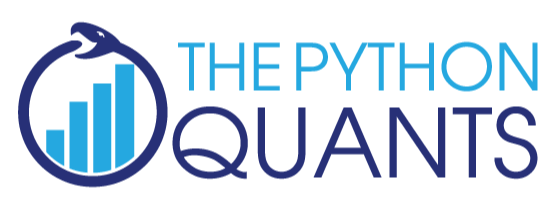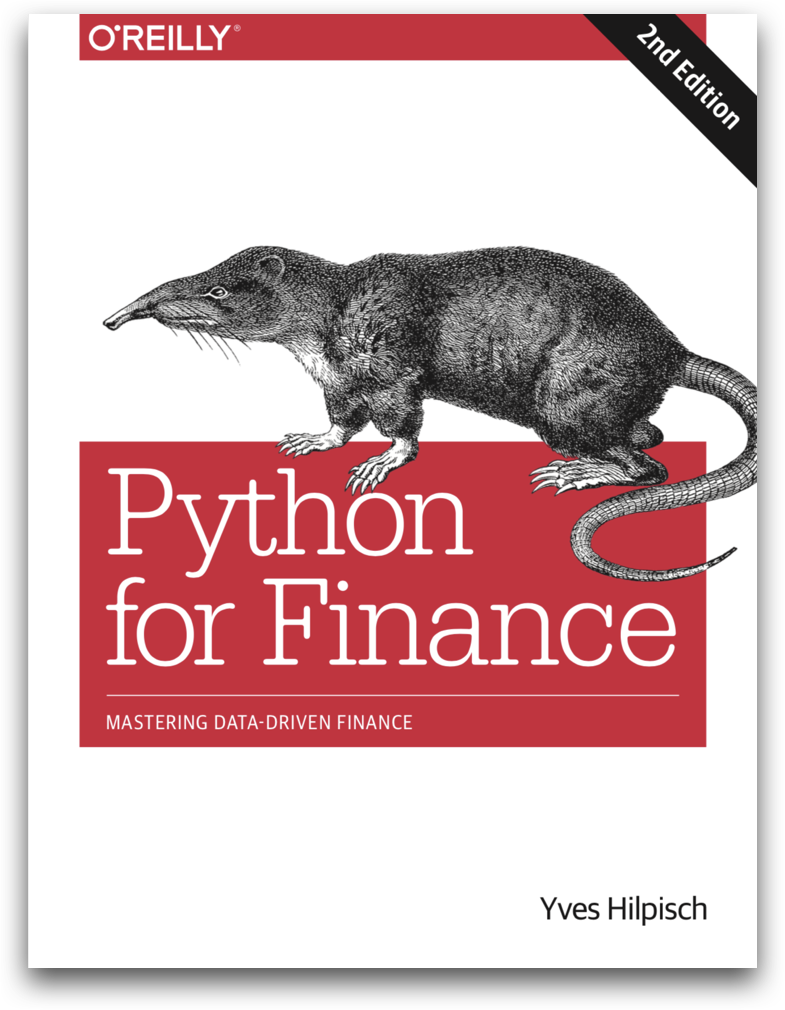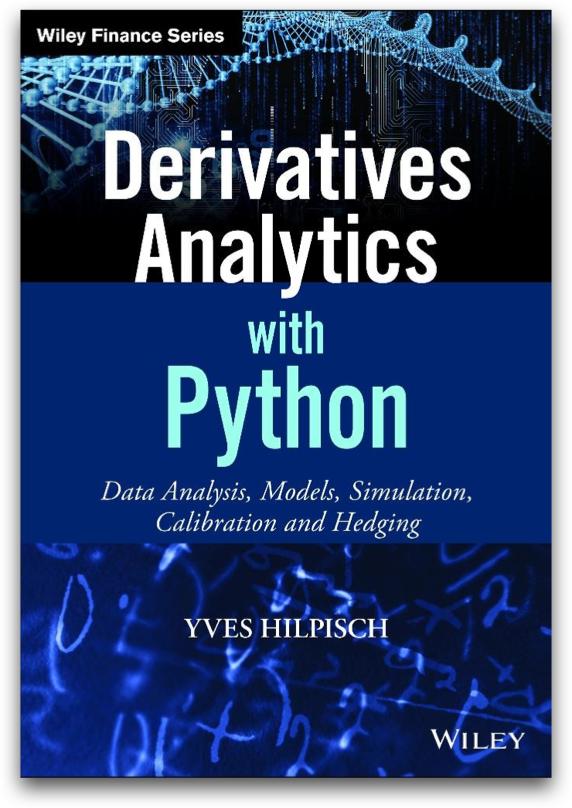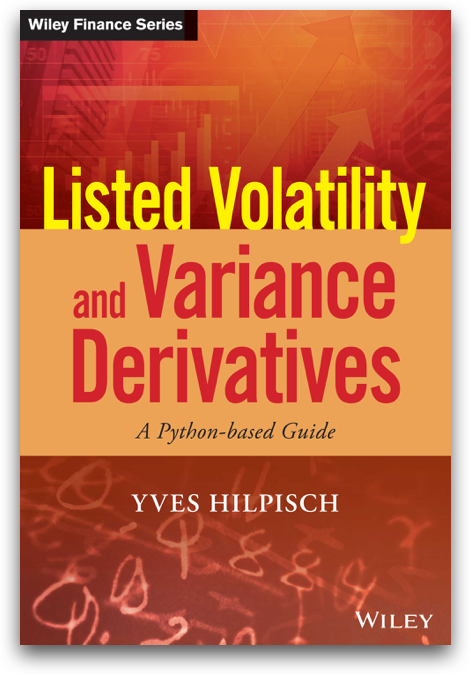
Market-Based Valuation of Equity Options¶
A Python-based Journey¶
Dr Yves J Hilpisch
The Python Quants GmbH
CQF Lecture, 09. April 2018, London
About TPQ & Me¶






I organize a number of events and training programs.
- For Python Quants Bootcamp (with CQF Institute) — http://fpq.io
- Python for Quant Finance Meetup Group London — http://pqf.tpq.io
- University Certificate in Python for Algorithmic Trading — http://certificate.tpq.io
More information and further links under http://tpq.io and https://hilpisch.com. Follow me on Twitter http://twitter.com/dyjh
Agenda¶
- Benchmark Case of Normally Distributed Returns
- Market Stylized Facts about Index Prices and Equity Options
- (Fourier-based Option Pricing)
- Basic Option Pricing with Python — Complete Markets
- Basic Option Pricing with Python — Incomplete Markets
- Merton (1976) Jump-Diffusion Model
- Monte Carlo Simulation in the Merton (1976) Model
- Calibration of the Merton (1976) Model to Market Quotes
Go to http://derivatives-analytics-with-python.com to find links to all the resources and Python codes (eg Quant Platform, Github repository).
The Benchmark Case¶
Let us first set the stage with standard normally distributed (pseudo-) random numbers ...
import numpy as np
a = np.random.standard_normal(1000)
a.mean()
-0.017192852033572143
a.std()
1.012459601404084
... and a simulated geometric Brownian motion (GBM) path. We make the following assumptions.
import math
import pandas as pd
# model parameters
S0 = 100.0 # initial index level
T = 10.0 # time horizon
r = 0.05 # risk-less short rate
vol = 0.2 # instantaneous volatility
# simulation parameters
np.random.seed(250000)
gbm_dates = pd.DatetimeIndex(start='30-09-2004',
end='31-08-2015',
freq='B')
M = len(gbm_dates) # time steps
dt = 1 / 252. # fixed for simplicity
df = math.exp(-r * dt) # discount factor
This function simulates GBM paths given the assumptions.
def simulate_gbm():
# stock price paths
rand = np.random.standard_normal((M, I)) # random numbers
S = np.zeros_like(rand) # stock matrix
S[0] = S0 # initial values
for t in range(1, M): # stock price paths
S[t] = S[t - 1] * np.exp((r - vol ** 2 / 2) * dt
+ vol * rand[t] * math.sqrt(dt))
gbm = pd.DataFrame(S[:, 0], index=gbm_dates, columns=['index'])
gbm['returns'] = np.log(gbm['index'] / gbm['index'].shift(1))
# Realized Volatility (eg. as defined for variance swaps)
gbm['rea_var'] = 252 * np.cumsum(gbm['returns'] ** 2) / np.arange(len(gbm))
gbm['rea_vol'] = np.sqrt(gbm['rea_var'])
gbm = gbm.dropna()
return gbm
Let us simulate a single path and inspect major statistics.
from gbm_helper import *
I = 1 # index level paths
gbm = simulate_gbm()
print_statistics(gbm)
RETURN SAMPLE STATISTICS --------------------------------------------- Mean of Daily Log Returns -0.000017 Std of Daily Log Returns 0.012761 Mean of Annua. Log Returns -0.004308 Std of Annua. Log Returns 0.202578 --------------------------------------------- Skew of Sample Log Returns -0.037438 Skew Normal Test p-value 0.413718 --------------------------------------------- Kurt of Sample Log Returns 0.106754 Kurt Normal Test p-value 0.239124 --------------------------------------------- Normal Test p-value 0.358108 --------------------------------------------- Realized Volatility 0.202578 Realized Variance 0.041038
Simulated prices and resulting log returns visulized.
%matplotlib inline
quotes_returns(gbm)
A histogram of the log returns compared to the normal distribution (with same mean/std).
return_histogram(gbm)
And a Quantile-Quantile QQ-plot of the log returns.
return_qqplot(gbm);
<matplotlib.figure.Figure at 0x118ff4c88>
The realized volatility over time.
realized_volatility(gbm)
Some rolling annualized statistics.
rolling_statistics(gbm)
Market Stylized Facts¶
We work with historical DAX data. The following function equips us with the necessary time series data.
from urllib.request import urlretrieve
urlretrieve('https://hilpisch.com/equities.h5', 'equities.h5')
('equities.h5', <http.client.HTTPMessage at 0x118e2fb00>)
def read_dax_data():
''' Reads historical DAX data from Yahoo! Finance, calculates log returns,
realized variance and volatility.'''
try:
h5 = pd.HDFStore('equities.h5', 'r')
except:
from urllib.request import urlretrieve
urlretrieve('https://hilpisch.com/equities.h5', 'equities.h5')
h5 = pd.HDFStore('equities.h5', 'r')
DAX = pd.DataFrame(h5['data']['^GDAXI'])
DAX = DAX[(DAX.index >= '30-09-2004') & (DAX.index <= '31-08-2015')]
DAX.rename(columns={'^GDAXI' : 'index'}, inplace=True)
print(DAX.tail())
DAX['returns'] = np.log(DAX['index'] / DAX['index'].shift(1))
DAX['rea_var'] = 252 * np.cumsum(DAX['returns'] ** 2) / np.arange(len(DAX))
DAX['rea_vol'] = np.sqrt(DAX['rea_var'])
DAX = DAX.dropna()
return DAX
Lets retrieve and inspect the data.
%time DAX = read_dax_data()
index Date 2015-08-25 10128.120117 2015-08-26 9997.429688 2015-08-27 10315.620117 2015-08-28 10298.530273 2015-08-31 10259.459961 CPU times: user 80 ms, sys: 11.2 ms, total: 91.2 ms Wall time: 94.7 ms
print_statistics(DAX)
RETURN SAMPLE STATISTICS --------------------------------------------- Mean of Daily Log Returns 0.000308 Std of Daily Log Returns 0.013992 Mean of Annua. Log Returns 0.077584 Std of Annua. Log Returns 0.222112 --------------------------------------------- Skew of Sample Log Returns -0.001354 Skew Normal Test p-value 0.977037 --------------------------------------------- Kurt of Sample Log Returns 6.520355 Kurt Normal Test p-value 0.000000 --------------------------------------------- Normal Test p-value 0.000000 --------------------------------------------- Realized Volatility 0.220012 Realized Variance 0.048405
The (in-memory) data structure.
DAX.info()
<class 'pandas.core.frame.DataFrame'> DatetimeIndex: 2695 entries, 2004-10-01 to 2015-08-31 Data columns (total 4 columns): index 2695 non-null float64 returns 2695 non-null float64 rea_var 2695 non-null float64 rea_vol 2695 non-null float64 dtypes: float64(4) memory usage: 105.3 KB
DAX[['index', 'returns', 'rea_var', 'rea_vol']].tail()
| index | returns | rea_var | rea_vol | |
|---|---|---|---|---|
| Date | ||||
| 2015-08-25 | 10128.120117 | 0.048521 | 0.048369 | 0.219929 |
| 2015-08-26 | 9997.429688 | -0.012988 | 0.048367 | 0.219924 |
| 2015-08-27 | 10315.620117 | 0.031331 | 0.048439 | 0.220089 |
| 2015-08-28 | 10298.530273 | -0.001658 | 0.048422 | 0.220049 |
| 2015-08-31 | 10259.459961 | -0.003801 | 0.048405 | 0.220012 |
The index levels and log returns.
quotes_returns(DAX)
A histogram of the log returns compared to the normal distribution (with same mean/std).
return_histogram(DAX)
The QQ-plot.
return_qqplot(DAX)
<matplotlib.figure.Figure at 0x1196ff320>
The realized volatility.
realized_volatility(DAX)
And finally the rolling annualized statistics.
rolling_statistics(DAX)
Finally, we want to look for jumps (heuristically). We use this simple function.
def count_jumps(data, value):
''' Counts the number of return jumps as defined in size by value. '''
jumps = np.sum(np.abs(data['returns']) > value)
return jumps
We define a jump as a log return higher in absolute value than 0.05.
count_jumps(DAX, 0.05) # "jumps" in the DAX index
31
count_jumps(gbm, 0.05) # "jumps" in the GBM path
0
In a Gaussian setting we have
- negative jumps:
$$P(r_n < −0.05) = 0.0002911$$
- positive jumps:
$$P(r_n > +0.05) = 0.0003402$$
for the DAX index given a return observation $r_n$. In such a setting the number of return observations lower than $-0.05$ and higher than $+0.05$ would be expected to be:
0.0002911 * len(DAX) # 'lower than -0.05'
0.7845144999999999
0.0003402 * len(DAX) # 'higher than +0.05'
0.916839
In summary, we "discover" the following stylized facts:
- stochastic volatility: volatility is neither constant nor deterministic; there is no mechanism to forecast volatility at a high confidence level
- volatility clustering: empirical data suggests that high volatility events seem to cluster in time; there is often a positive autocorrelation of volatility measures
- volatility mean reversion: volatility is a mean-reverting quantity — it never reaches zero nor does it go to infinity; however, the mean can change over time
- leverage effect: our data suggests that volatility is negatively correlated (on average) with asset returns; if return measures increase, volatility measures often decrease and vice versa
- fat tails: compared to a normal distribution large positive and negative index returns are more frequent
- jumps: index levels may move by magnitudes that cannot be explained within a Gaussian, i.e. normal, diffusion setting; some jump component may be necessary to explain certain large moves
Important add-on topic: volatility smiles and term structure — here implied volatilities from European call options on the EURO STOXX 50 on 30. September 2014.
%run es50_imp_vol.py
<matplotlib.figure.Figure at 0x118f76208>
data.tail()
| Date | Strike | Call | Maturity | Put | |
|---|---|---|---|---|---|
| 498 | 2014-09-30 | 3750.0 | 27.4 | 2015-09-18 | 635.9 |
| 499 | 2014-09-30 | 3800.0 | 21.8 | 2015-09-18 | 680.3 |
| 500 | 2014-09-30 | 3850.0 | 17.2 | 2015-09-18 | 725.7 |
| 501 | 2014-09-30 | 3900.0 | 13.4 | 2015-09-18 | 772.0 |
| 502 | 2014-09-30 | 3950.0 | 10.4 | 2015-09-18 | 818.9 |
The calculation of the implied volatilities and the visualization.
%time imp_vols = calculate_imp_vols(data)
CPU times: user 10.6 s, sys: 40.8 ms, total: 10.7 s Wall time: 10.7 s
plot_imp_vols(data)
Option Pricing with Python¶
Some live examples.
Fourier-based Option Pricing¶
The Fourier-based option pricing approach has three main advantages:
- generality: the approach is applicable whenever the characteristic function of the process driving uncertainty is known; and this is the case for the majority of processes/models applied in practice
- accuracy: the semi-analytic formulas can be evaluated numerically in such a way that a high degree of accuracy is reached at little computational cost (e.g. compared to simulation techniques)
- speed: the formulas can in general be evaluated very fast such that 10s, 100s or even 1,000s of options can be valued per second
Let us start with a market model of the form:
$$ \mathcal{M} = \{(\Omega,\mathcal{F},\mathbb{F},P),T,(S,B)\} $$
- $(\Omega,\mathcal{F},\mathbb{F},P)$ is a filtered probability space
- $T>0$ is a fixed time horizon
- $(S,B)$ are two traded assets, $S$ a risky one and $B$ a risk-less one
We then know that the arbitrage value of an attainable European call option is
$$ C_{t}=e^{-r(T-t)}\mathbf{E}^{Q}_{t}(C_{T}) $$
where $C_{T}\equiv\max[S_{T}-K,0]$ for a strike $K>0$. In integral from, setting $t=0$, call option pricing reads
$$ \begin{eqnarray} C_{0}&=&e^{-rT}\int_{0}^{\infty} C_{T}(s) Q(ds) \nonumber\\ &=&e^{-rT}\int_{0}^{\infty} C_{T}(s) q(s) ds \end{eqnarray} $$
where $q(s)$ is the risk-neutral probability density function (pdf) of $S_{T}$. Unfortunately, the pdf is quite often not known in closed form — whereas the characteristic function (CF) of $S_{T}$ is.
The fundamental insight of Fourier-based option pricing is to replace both the pdf by the CF and the call option payoff $C_{T}$ by its Fourier transform.
Let a random variable $X$ be distributed with pdf $q(x)$. The characteristic function $\hat{q}$ of $X$ is the Fourier transform of its pdf
$$ \hat{q}(u)\equiv \int_{-\infty}^{\infty}e^{iux} q(x) dx = \mathbf{E}^{Q}\left(e^{iuX}\right) $$
For $u=u_{r}+iu_{i}$ with $u_{i}>1$, the Fourier transform of the European call option payoff $C_{T} = \max[S_T - K, 0]$is given by:
$$\widehat{C}_{T}(u)= -\frac{K^{iu+1}}{u^2-iu}$$
Lewis (2001): With $\varphi$ as the CF of the rv $S_T$ and assuming $u_{i}\in (0,1)$, the call option present value is $$ C_{0}=S_{0}-\frac{Ke^{-rT}}{2\pi}\int_{-\infty+iu_{i}}^{\infty+iu_{i}} e^{-iuk} \varphi(-u) \frac{du}{u^2-ui} $$
Furthermore, setting $u_{i}=0.5$ gives
$$ C_{0}=S_{0}-\frac{\sqrt{S_{0}K}e^{-rT/2}}{\pi}\int_{0}^{\infty} \mathbf{Re}\left[e^{izk} \varphi(z-i/2)\right] \frac{dz}{z^2+1/4} $$ where $\mathbf{Re}[x]$ denotes the real part of $x$.
The Merton (1976) Jump-Diffusion Model¶
In the Merton (1976) jump-diffusion model, the risk-neutral index level dynamics are given by the SDE
$$ dS_{t}=(r-r_{J})S_{t}dt+\sigma S_{t}dZ_{t}+J_{t}S_{t}dN_{t} $$
The variables and parameters have the following meaning:
- $S_{t}$ index level at date $t$
- $r$ constant risk-less short rate
- $r_{J}\equiv \lambda \cdot \left(e^{\mu_{J}+\delta^{2}/2}-1\right)$ drift correction for jump
- $\sigma$ constant volatility of $S$
- $Z_{t}$ standard Brownian motion
- $J_{t}$ jump at date $t$ with distribution $\log(1+J_{t}) \approx \mathbf{N}\left(\log(1+\mu_{J})-\frac{\delta^{2}}{2},\delta^{2}\right)$
- $\mathbf{N}$ as the cumulative distribution function of a standard normal random variable
- $N_{t}$ Poisson process with intensity $\lambda$
The characteristic function for the Merton (1976) model is given as:
$$ \varphi_{0}^{M76}(u,T)=\exp\left(\left(iu\omega -\frac{u^{2}\sigma^{2}}{2}+\lambda \left(e^{iu\mu_{J}-u^{2}\delta^{2}/2}-1\right)\right)T\right) $$
where the risk-neutral drift term $\omega$ takes on the form
$$ \omega=r-\frac{\sigma^{2}}{2}-\lambda\left(e^{\mu_{J}+\delta^{2}/2}-1\right) $$
Combining this with the option pricing result from Lewis (2001) we get for the price of a European call option
$$ C_{0}=S_{0}-\frac{\sqrt{S_{0}K}e^{-rT/2}}{\pi}\int_{0}^{\infty} \mathbf{Re}\left[e^{izk} \varphi_{0}^{M76}(z-i/2,T)\right] \frac{dz}{z^2+1/4} $$
Let us implement European call option in Python. First, the characteristic function.
import math
import numpy as np
from scipy.integrate import quad
def M76_characteristic_function(u, T, r, sigma, lamb, mu, delta):
omega = r - 0.5 * sigma ** 2 - lamb * (np.exp(mu + 0.5 * delta ** 2) - 1)
value = np.exp((1j * u * omega - 0.5 * u ** 2 * sigma ** 2 +
lamb * (np.exp(1j * u * mu - u ** 2 * delta ** 2 * 0.5) - 1)) * T)
return value
Second, the integration function.
def M76_integration_function(u, S0, K, T, r, sigma, lamb, mu, delta):
JDCF = M76_characteristic_function(u - 0.5 * 1j, T, r,
sigma, lamb, mu, delta)
value = 1 / (u ** 2 + 0.25) * (np.exp(1j * u * math.log(S0 / K))
* JDCF).real
return value
Third, the evaluation of the integral via numerical quadrature.
def M76_value_call_INT(S0, K, T, r, sigma, lamb, mu, delta):
int_value = quad(lambda u: M76_integration_function(u, S0, K, T, r,
sigma, lamb, mu, delta), 0, 50, limit=250)[0]
call_value = S0 - np.exp(-r * T) * math.sqrt(S0 * K) / math.pi * int_value
return call_value
Fourth, a numerical example.
S0 = 100.0 # initial index level
K = 100.0 # strike level
T = 1.0 # call option maturity
r = 0.05 # constant short rate
sigma = 0.4 # constant volatility of diffusion
lamb = 1.0 # jump frequency p.a.
mu = -0.2 # expected jump size
delta = 0.1 # jump size volatility
print ("Value of Call Option %8.3f" \
% M76_value_call_INT(S0, K, T, r, sigma, lamb, mu, delta))
Value of Call Option 19.948
Monte Carlo Simulation¶
To value a European call option with strike price $K$ by MCS consider the following discretization of the Merton (1976) SDE
$$ S_{t}=S_{t-\Delta t}\left(e^{(r-r_{J}-\sigma^{2}/2)\Delta t+\sigma \sqrt{\Delta t}z^{1}_{t}}+ \left(e^{\mu_{J}+\delta z^{2}_{t}}-1\right)y_{t}\right) $$
with the $z^{n}_{t}$ being standard normally distributed and the $y_{t}$ being Poisson distributed with intensity $\lambda$.
The Python code implementing the MCS:
def M76_generate_paths(S0, T, r, sigma, lamb, mu, delta, M, I):
dt = T / M
rj = lamb * (math.exp(mu + 0.5 * delta ** 2) - 1)
shape = (M + 1, I)
S = np.zeros((M + 1, I), dtype=np.float)
S[0] = S0
np.random.seed(10000)
rand1 = np.random.standard_normal(shape)
rand2 = np.random.standard_normal(shape)
rand3 = np.random.poisson(lamb * dt, shape)
for t in range(1, M + 1, 1):
S[t] = S[t - 1] * (np.exp((r - rj - 0.5 * sigma ** 2) * dt
+ sigma * math.sqrt(dt) * rand1[t])
+ (np.exp(mu + delta * rand2[t]) - 1)
* rand3[t])
return S
The function in action.
M = 100 # time steps
I = 10 # paths
S = M76_generate_paths(S0, T, r, sigma, lamb, mu, delta, M, I)
The paths visualized.
import matplotlib.pyplot as plt
plt.figure(figsize=(10, 6))
plt.plot(S);
As simple function to value a European call option by MCS.
def M76_value_call_MCS(K):
return math.exp(-r * T) * np.sum(np.maximum(S[-1] - K, 0)) / I
%%time
I = 200000
S = M76_generate_paths(S0, T, r, sigma, lamb, mu, delta, M, I)
print ("Value of Call Option %8.3f" % M76_value_call_MCS(K))
Value of Call Option 19.941 CPU times: user 2.46 s, sys: 299 ms, total: 2.76 s Wall time: 2.78 s
The model of Merton (1976) is capable of generating a volatility smile.
start = pd.Timestamp('2015-1-1')
end = pd.Timestamp('2016-1-1')
strikes = range(50, 151, 10)
plt.figure(figsize=(10, 6))
for l in np.arange(0, 1.0, 0.2):
imp_vols = []
for k in strikes:
call = call_option(S0, k, start, end, r, 0.2)
M76_value = M76_value_call_INT(S0, k, T, r, sigma, l, mu, delta)
imp_vols.append(call.imp_vol(M76_value))
plt.plot(strikes, imp_vols, label='$\lambda$=%2.1f' % l)
plt.legend(loc=0); plt.savefig('vol_smile.png')
Calibration of the Model¶
In simple terms, the problem of calibration is to find parameters for the Merton (1976) model such that observed market quotes of liquidly traded plain vanilla options are replicated as good as possible. To this end, one defines an error function that is to be minimized. Such a function could be the Root Mean Squared Error (RMSE). The task is then to solve the problem
$$ \min_{\sigma, \lambda, \mu_{J}, \delta } \sqrt{\frac{1}{N}\sum_{n=1}^{N}\left( C_{n}^{*} - C_{n}^{M76}(\sigma, \lambda, \mu_{J}, \delta )\right)^{2}} $$ with the $C_{n}^{*}$ being the market or input prices and the $C_{n}^{M76}$ being the model or output prices for the options $n=1,...,N$.
EXCURSION: The minimization problem is ill-posed (I). Let's analyze properties of the error function for a single European call option.
C0 = M76_value_call_INT(S0, K, T, r, sigma, lamb, mu, delta)
def error_function(p0):
sigma, lamb, mu, delta = p0
return abs(C0 - M76_value_call_INT(S0, K, T, r, sigma, lamb, mu, delta))
EXCURSION: The minimization problem is ill-posed (II).
def plot_error_function():
plt.figure(figsize=(10, 6))
# Plotting (lamb)
l = np.linspace(-0.5, 1.5, 100); EFv = []
for i in l:
EFv.append(error_function([sigma, i, mu, delta]))
plt.plot(l, EFv, label='$\lambda$')
plt.xlabel('parameter values')
plt.ylabel('error function values c.p.')
# Plotting (mu)
l = np.linspace(-0.3, 0.3, 100); EFv = []
for i in l:
EFv.append(error_function([sigma, lamb, i, delta]))
plt.plot(l, EFv, label='$\mu$')
# Plotting (delta)
l = np.linspace(-0.3, 0.3, 100); EFv = []
for i in l:
EFv.append(error_function([sigma, lamb, mu, i]))
plt.plot(l, EFv, label='$\delta$')
plt.legend(loc=0)
EXCURSION: The minimization problem is ill-posed (III).
plot_error_function()
EXCURSION: The simple example illustrates that the calibration of the Merton (1976) jump diffusion model leads to a number of problems:
- convexity: the error function is only locally convex
- determinacy: the error function exhibits multiple minima
- degeneracy: different parameter combinations yield the same result
- consistency: the approach mathematically allows parameter values that are economically implausible
- stability: slight changes in the input values can change the solution significantly ('sudden' change from one local minimum to another is possible)
Let us import some real option quotes for European call options on the EURO STOXX 50 index.
import pandas as pd
h5 = pd.read_csv('https://hilpisch.com/es50_option_data.csv', index_col=0)
data['Date'] = data['Date'].apply(lambda x: pd.Timestamp(x))
data['Maturity'] = data['Maturity'].apply(lambda x: pd.Timestamp(x))
S0 = 3225.93 # EURO STOXX 50 level
r = 0.005 # assumption
# Option Selection
tol = 0.05
options = data[(np.abs(data['Strike'] - S0) / S0) < tol]
mats = sorted(set(options['Maturity']))
options = options[options['Maturity'] == mats[0]]
These are the option quotes we are dealing with (I).
options
| Date | Strike | Call | Maturity | Put | Imp_Vol | |
|---|---|---|---|---|---|---|
| 452 | 2014-09-30 | 3075.0 | 167.0 | 2014-10-17 | 9.3 | 0.272313 |
| 453 | 2014-09-30 | 3100.0 | 144.5 | 2014-10-17 | 11.7 | 0.255501 |
| 454 | 2014-09-30 | 3125.0 | 122.7 | 2014-10-17 | 14.9 | 0.239363 |
| 455 | 2014-09-30 | 3150.0 | 101.8 | 2014-10-17 | 19.1 | 0.223913 |
| 456 | 2014-09-30 | 3175.0 | 82.3 | 2014-10-17 | 24.5 | 0.210099 |
| 457 | 2014-09-30 | 3200.0 | 64.3 | 2014-10-17 | 31.5 | 0.197051 |
| 458 | 2014-09-30 | 3225.0 | 48.3 | 2014-10-17 | 40.5 | 0.185345 |
| 459 | 2014-09-30 | 3250.0 | 34.6 | 2014-10-17 | 51.8 | 0.174854 |
| 460 | 2014-09-30 | 3275.0 | 23.5 | 2014-10-17 | 65.8 | 0.165798 |
| 461 | 2014-09-30 | 3300.0 | 15.1 | 2014-10-17 | 82.3 | 0.158392 |
| 462 | 2014-09-30 | 3325.0 | 9.1 | 2014-10-17 | 101.3 | 0.152121 |
| 463 | 2014-09-30 | 3350.0 | 5.1 | 2014-10-17 | 122.4 | 0.146688 |
| 464 | 2014-09-30 | 3375.0 | 2.8 | 2014-10-17 | 145.0 | 0.143796 |
These are the option quotes we are dealing with (II).
options['Call'].plot(style='o', figsize=(10, 6));
Next, we define an error function in Python for the calibration.
i = 0; min_RMSE = 100.
def M76_error_function(p0):
global i, min_RMSE
sigma, lamb, mu, delta = p0
if sigma < 0.0 or delta < 0.0 or lamb < 0.0:
return 500.0
se = []
for row, option in options.iterrows():
T = (option['Maturity'] - option['Date']).days / 365.
model_value = M76_value_call_INT(S0, option['Strike'], T,
r, sigma, lamb, mu, delta)
se.append((model_value - option['Call']) ** 2)
RMSE = math.sqrt(sum(se) / len(se))
min_RMSE = min(min_RMSE, RMSE)
if i % 100 == 0:
print ('%4d |' % i, np.array(p0), '| %7.3f | %7.3f' % (RMSE, min_RMSE))
i += 1
return RMSE
The calibration is done in two steps. First, a global optimization.
%%time
import scipy.optimize as sop
np.set_printoptions(suppress=True,
formatter={'all': lambda x: '%6.3f' % x})
p0 = sop.brute(M76_error_function, ((0.10, 0.201, 0.025),
(0.10, 0.80, 0.10), (-0.40, 0.01, 0.10),
(0.00, 0.121, 0.02)), finish=None)
0 | [ 0.100 0.100 -0.400 0.000] | 12.676 | 12.676 100 | [ 0.100 0.300 0.000 0.020] | 15.240 | 7.372 200 | [ 0.100 0.600 -0.100 0.060] | 11.777 | 2.879 300 | [ 0.125 0.200 -0.200 0.100] | 9.004 | 2.443 400 | [ 0.125 0.500 -0.200 0.000] | 5.056 | 1.125 500 | [ 0.150 0.100 -0.300 0.040] | 6.109 | 0.970 600 | [ 0.150 0.400 -0.400 0.080] | 4.135 | 0.970 700 | [ 0.150 0.600 0.000 0.120] | 6.333 | 0.970 800 | [ 0.175 0.200 0.000 0.020] | 5.955 | 0.970 900 | [ 0.175 0.500 -0.100 0.060] | 5.536 | 0.970 1000 | [ 0.200 0.100 -0.200 0.100] | 8.596 | 0.970 1100 | [ 0.200 0.400 -0.200 0.000] | 10.692 | 0.970 1200 | [ 0.200 0.700 -0.300 0.040] | 17.578 | 0.970 CPU times: user 53.3 s, sys: 133 ms, total: 53.4 s Wall time: 53.4 s
Second, the local (convex) optimization.
%%time
opt = sop.fmin(M76_error_function, p0, xtol=0.00001,
ftol=0.00001, maxiter=750, maxfun=1500)
1300 | [ 0.122 0.723 -0.247 0.110] | 0.798 | 0.798
1400 | [ 0.119 1.001 -0.187 0.013] | 0.769 | 0.768
1500 | [ 0.119 1.031 -0.183 0.000] | 0.767 | 0.767
1600 | [ 0.119 1.033 -0.183 0.000] | 0.767 | 0.767
Optimization terminated successfully.
Current function value: 0.766508
Iterations: 278
Function evaluations: 477
CPU times: user 17 s, sys: 36.4 ms, total: 17 s
Wall time: 17 s
The optimal parameter values are:
i = 0
M76_error_function(p0)
0 | [ 0.125 0.600 -0.300 0.120] | 0.970 | 0.767
0.9695219560421178
i = 0
M76_error_function(opt)
0 | [ 0.119 1.033 -0.183 0.000] | 0.767 | 0.767
0.7665083562548708
Comparison of market and model prices (I).
def generate_plot(opt, options):
sigma, lamb, mu, delta = opt
options['Model'] = 0.0
for row, option in options.iterrows():
T = (option['Maturity'] - option['Date']).days / 365.
options.loc[row, 'Model'] = M76_value_call_INT(S0, option['Strike'],
T, r, sigma, lamb, mu, delta)
options = options.set_index('Strike')
fig, ax = plt.subplots(2, sharex=True, figsize=(8, 7))
options[['Call', 'Model']].plot(style=['b-', 'ro'],
title='%s' % str(option['Maturity'])[:10], ax=ax[0])
ax[0].set_ylabel('option values')
xv = options.index.values
ax[1] = plt.bar(xv - 5 / 2., options['Model'] - options['Call'],
width=5)
plt.ylabel('difference')
plt.xlim(min(xv) - 10, max(xv) + 10)
plt.tight_layout()
Comparison of market and model prices (II).
generate_plot(opt, options)
Finally, a look at the implied volatilities.
S0 = 3225.93; r = 0.005
def calc_imp_vols(data):
data['Imp_Vol_Mod'] = 0.0
data['Imp_Vol_Mar'] = 0.0
tol = 0.30 # tolerance for moneyness
for row in data.index:
t = data['Date'][row]
T = data['Maturity'][row]
ttm = (T - t).days / 365.
forward = np.exp(r * ttm) * S0
if (abs(data['Strike'][row] - forward) / forward) < tol:
call = call_option(S0, data['Strike'][row], t, T, r, 0.2)
data['Imp_Vol_Mod'][row] = call.imp_vol(data['Model'][row])
data['Imp_Vol_Mar'][row] = call.imp_vol(data['Call'][row])
return data
The calculation of the model implied volatilities and a comparison.
options = calc_imp_vols(options)
options[['Imp_Vol_Mar', 'Imp_Vol_Mod']].plot(figsize=(10, 6), style=['b^', 'ro'])
<matplotlib.axes._subplots.AxesSubplot at 0x118f69048>
Conclusions¶
In conclusion, we can state the following:
- markets: time series in financial markets strongly deviate from the Gaussian benchmark(s); there are generally eg stochastic volatility, jumps, implied volatility smiles observed in historical data
- Merton (1976) model: the model of Merton is capable of accounting for some observed stylized facts like jumps and volatility smiles
- calibration issues: numerical finance and optimization (i.e. calibration) faces a number of issues, eg with regard the determinacy of solutions and convexity of error functions
- Python: Python is really close to mathematical and financial syntax; the implementation of financial algorithms generally is efficient and performant (when using the right libraries and idioms like NumPy with vectorization)
All details, codes, proofs, etc. in the book "Derivatives Analytics with Python" — cf. http://derivatives-analytics-with-python.com.

http://tpq.io | @dyjh | team@tpq.io
Training | http://training.tpq.io
Quant Platform | http://quant-platform.com
Python for Finance | Python for Finance @ O'Reilly
Derivatives Analytics with Python | Derivatives Analytics @ Wiley Finance